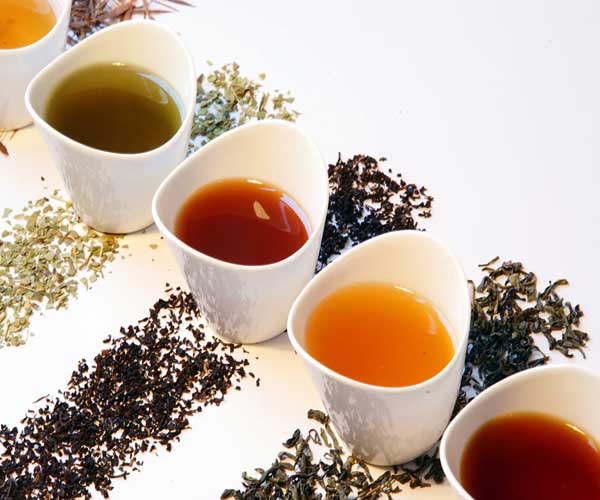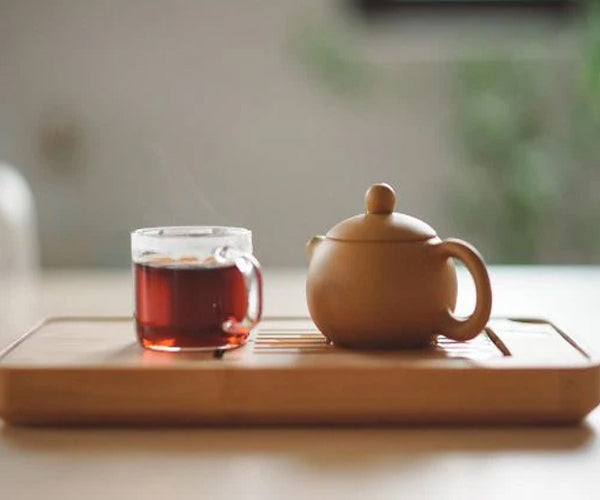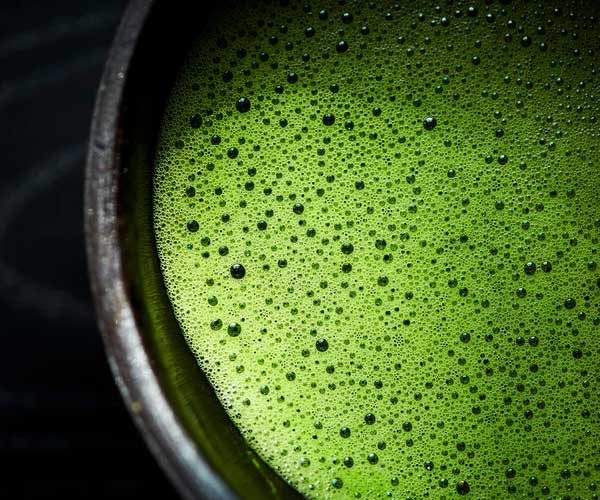How many types of tea are there? Well, you could say there are more than 1,500 types of tea in the world, but they are divided into six main categories.
The amazing thing is that all real, genuine teas come from one and the same plant, the Camellia Sinensis .
The production of the tea has a strong influence on the aromas and fragrances, so no two teas are the same, even though they come from the same plant.
But which 6 types of tea or tea categories am I talking about here? Let's start with the most well-known tea:
Black tea
The best-known and most common type of tea is black tea, known primarily as Assam or Darjeeling. Many also consider Earl Grey and similar teas to be black teas, but these are simply blends based on black tea.
Black tea is mainly grown in China, Sri Lanka, and other Asian countries. The leaves are picked, withered, cut or rolled, oxidized, and then dried. Black tea is the most highly oxidized type of tea, as the oxidation process is carried out to completion. With other types, such as white tea, the process is stopped prematurely by drying.
In China, black tea is known as red tea because the liquid of the brewed tea has a red color.
Effects of black tea on health
Black tea isn't just popular for its taste—it also has some interesting health benefits. Its caffeine content (about 25 milligrams per 100 milliliters) makes it stimulating yet gentle—ideal for mornings when only a cup of Assam or Darjeeling can help.
But its appeal goes beyond just being a stimulant: Studies suggest that regular consumption of about four cups a day can lower blood pressure and support the cardiovascular system. This is due to natural plant compounds such as flavonoids, which have a positive effect on blood vessels and have antioxidant properties.
As with many things, however, the rule here is: enjoy in moderation. Too much black tea can irritate the stomach lining or occasionally cause headaches. However, in the right amount, it can be easily integrated into a balanced daily routine.
White tea
The least processed type of tea is white tea; the leaves are neither rolled nor crushed during processing, making this tea the most delicate in terms of taste and aroma.
The leaves are simply picked, wilted and then dried.
White teas are made from the buds and leaves of Camellia sinensis. During harvesting, great care is taken to ensure the leaves are not broken or crushed. The color of the tea is, as the name suggests, very light.
Health benefits and ingredients of white tea
White tea enjoys an excellent reputation not only for its delicate taste, but is also valued for its valuable ingredients and health benefits.
White tea has been known for centuries to have a particularly high content of natural antioxidants. These so-called polyphenols – especially catechins – can help strengthen the immune system and protect cells from oxidative stress. This makes it, for many, the "healthiest" type of tea.
In addition to antioxidants, white tea also provides various vitamins and minerals. Vitamin B1 (thiamine) is particularly noteworthy, contributing to the normal functioning of the nervous system. White tea also contains traces of vitamin C and minerals such as potassium, calcium, and magnesium.
So, if you're looking for a mild yet potent tea, white tea is an excellent choice – gentle in aroma and full of valuable ingredients. The delicate, sometimes even floral-sweet notes also make it a special taste experience.
Green tea
Arguably the oldest type of tea is green tea, which is only slightly oxidized . It is often assumed that green tea is not oxidized at all, but this is not true. The leaves are picked, wilted, and then either pan-roasted or steamed to prevent oxidation. to stop.
Pan roasting is preferred for Chinese tea, while steaming is more common for Japanese tea. Depending on the preparation method, the flavor naturally changes and can be grassier with steaming than with roasting.
For fresh tea infusions, it is recommended not to store green tea for longer than one year so that it can develop its full aroma.
Matcha is often considered a green tea, which isn't actually a mistake, as it's actually a green tea ( tencha ) that's ground into a fine powder. After preparation, you don't just consume the infusion, but the whole leaf, as the powder dissolves.
How green tea affects the body
You may be wondering what green tea actually does to your body—aside from its distinctive flavor, which ranges from mildly grassy to slightly bitter depending on how it's processed. One of its most well-known effects is its gentle stimulation: Green tea contains less caffeine than black tea, so it's invigorating without keeping you awake at night (yes, that's right—I'm talking about you, midnight coffee junkie!).
Its effect on metabolism is also exciting. Thanks to natural plant compounds such as flavonoids, regular consumption of green tea is believed to support metabolism—good news if you're keeping an eye on your health goals. Green tea also has benefits for your teeth: Thanks to its antibacterial properties and the catechins it contains, it can help prevent cavities and keep your teeth healthy.
With over a hundred valuable plant compounds in each leaf, green tea is far more than a calming drink – it is a real powerhouse for body and mind.
Yellow tea
Yellow tea is a very rare type of tea , and is currently only produced in small quantities in China. Only experienced tea masters possess the skills to manage this lengthy production process.
There are two quality levels of yellow tea:
High-quality yellow tea is made from buds picked in spring.
Low-quality yellow tea, on the other hand, comes from buds and leaves that are picked later in the year.
In principle, the processing of yellow tea is similar to that of green tea. However, an additional step is added during processing: In the so-called "yellow phase," the leaves are wrapped in paper. Skipping this step would turn the tea into green tea.
Oolong tea
In terms of character, Oolong It's best classified between green and black tea. An oolong can have the soft flavors of green tea, in which case it has been lightly oxidized, or it can be heavily oxidized and thus acquire stronger flavors, like a black tea.
The special visual characteristic of this semi-oxidized tea is the curled, twisted or tightly rolled leaves.
These are picked before partial oxidation, wilted, and then crushed. The color of the leaves indicates the extent of oxidation, which for oolong teas can range from 10% to 80%. The redder or darker the color of the leaves, the greater the oxidation. Some varieties are roasted after oxidation. The best-known and most popular oolong tea varieties are Dong Ding and Tie Guan Yin.
Benefits of Oolong Tea Compared to Other Tea Types
Oolong teas not only taste between green and black tea, but also offer several advantages that set them apart from other types of tea:
Digestibility: Due to its lower tannin content, oolong tea is considered particularly gentle on the stomach. Those sensitive to the bitter taste or stronger effects of black tea will find oolong a gentle alternative.
Brewing time: While black tea can quickly become bitter, oolong tea retains its pleasantly mild flavor even with longer brewing times. This makes it ideal for multiple brews.
Variety: Since the degree of oxidation varies greatly, the aroma spectrum ranges from light and floral to strong and roasted. This allows you to find your personal favorite through experimentation—comparable to classics like Dong Ding or Tie Guan Yin.
Aroma development: Due to the special processing, oolong teas develop new, refined nuances with each cup, which often appear more complex than green or black tea.
With these properties, oolong tea is a versatile choice for those seeking variety or who value mild, easily digestible teas.
Pu-Erh Tea / Dark Tea
Pu-erh originates from the southern Chinese province of Yunnan and is offered in a variety of forms. After production, it is pressed into molds and dried, allowing the Pu-erh to be stored and matured for many years.
Before the special production process for Pu-Erh begins, the raw green tea is prepared by withering, steaming and rolling.
There are two categories of Pu-Erh:
Sheng Pu-Erh / Raw Pu-Erh
In the traditional process, the raw tea is pressed into various shapes, and this freshly pressed tea undergoes a maturation process that transforms it into aged or "matured tea." This natural transformation can take several years or even decades.
This traditional process was originally developed to preserve green tea for transport and trade to distant countries. The tea leaves are first wilted in the sun, then steamed and pressed into bricks, cakes, or balls under controlled heat. During transport or storage, the tea undergoes a maturation process through chemical reactions between the natural components of the tea leaves.
Maturation takes at least five years, and the tea gains flavor with age. Microorganisms play a crucial role in this process.
Shu Pu-Erh / Mature Pu-Erh
For mature Pu-erh, the fermentation process is accelerated through a special process. Before pressing, the raw tea undergoes a controlled fermentation. Although it can continue to mature like raw Pu-erh, it is ready for sale after just a few weeks.
The raw tea is moistened with water and spread out loosely in a closed space. A tarpaulin or straw mat covers the tea, and under controlled conditions, the maturation process can begin.
This fermentation process, similar to composting, is initiated by the molds Penicillium, Aspergillus, and other yeasts. This process is considerably faster, and the tea is ready for pressing after about 48 days.
As the flavors of Pu-Erh improve over time, this tea is highly valued among connoisseurs, making Pu-Erh the most popular dark tea.
How does Pu-Erh tea taste compared to other types of tea?
Pu-erh tea is difficult to categorize in terms of taste. It lies somewhere between green tea and black tea, combining earthy depth with soft, harmonious notes. Unlike the fresh, grassy nuances of green tea or the strong, malty aroma of black varieties like Assam or Darjeeling, Pu-erh tea develops a rounded flavor profile that evolves with age.
Young Sheng Pu-Erh tastes slightly floral to grassy and fresh, while well-aged varieties develop complex aromas—earthy, woody, or with a subtle sweetness. Connoisseurs sometimes detect hints of dried fruit, leather, or mushrooms. Shu Pu-Erh, which matures through accelerated fermentation, produces a darker cup with an almost velvety mouthfeel and pronounced earthy to mineral notes.
Compared to oolong teas like Tie Guan Yin, which can be floral or creamy depending on the degree of oxidation, Pu-erh has a unique aroma thanks to its special fermentation process – rich, sometimes slightly musty, but always smooth. Those seeking a tea with depth and character will enjoy Pu-erh precisely because of its complex and versatile flavors.
Potential health benefits of Pu-erh tea
As with many other traditional teas, Pu-Erh tea is also the subject of numerous reports about its potential positive health effects.
For example, the following effects are attributed to Pu-Erh tea:
Supports digestion: Due to the special fermentation, the tea contains many microorganisms that can have a positive effect on the intestinal flora.
Cholesterol-lowering properties: Some studies, such as those from Zhejiang University, indicate that Pu-erh tea can help regulate cholesterol levels.
Promotes metabolism: Pu-Erh is often drunk in Asia as an accompaniment to fatty foods, as it is said to stimulate fat burning.
A pleasurable ritual with a potential feel-good factor: Although many of these effects have not been conclusively proven scientifically, tea lovers often appreciate the relaxing effect of traditional preparation and enjoyment.
Of course, Pu-Erh tea is not a miracle cure, but like all teas and “home remedies,” it should be incorporated into a balanced diet.
Following this, I would also like to discuss other "teas" that aren't actually true teas. Why do we even say "true tea"? We all know fruit teas and herbal teas, but strictly speaking, these are only tea-like products, because only infusions made from Camellia sinensis components are truly teas.
” The guidelines for tea and tea-like products stipulate that genuine tea must always be made from the tea plant Camelia sinensis.
Susanne Moritz, nutrition expert at the Bavarian Consumer Center
Herbal teas are also brewed in hot water like tea to extract the product's aromas. Well-known herbal teas include peppermint, rooibos, and chamomile.
Products sold as tea but not derived from Camellia sinensis are therefore not teas, but rather herbal teas or infusions. Another important point to consider is that real tea contains varying amounts of caffeine, also called theine, while an infusion or herbal tea contains no caffeine at all.
Kombucha
Although kombucha is made from a Camellia sinensis product, it is not a distinct type of tea. Therefore, real black, white, or green tea is used in its production.
Kombucha is produced by fermenting tea and a suitable kombucha culture (called a kombucha fungus, SCOBY, or tea fungus). During fermentation, three processes occur: alcoholic fermentation, lactic acid fermentation, and acetic acid fermentation.
Teas for every need: relaxation, balance and fasting
Now that we've clarified the difference between real tea and herbal infusions, it's worth taking a look at which teas and tea-like beverages are particularly well-suited to specific needs. Are you wondering: "Which tea helps me find inner peace? Which brings me balance? And what's best to drink while fasting?" Here are a few tried-and-true recommendations:
For relaxation
Herbal teas are true classics when it comes to unwinding. Peppermint tea is refreshing yet calming—ideal for the evening to clear your head. Chamomile tea, prized for centuries, is the epitome of a calming evening tea. And lemon balm (Melissa officinalis) delights with its delicate citrus notes and helps many people unwind after a long day.
For inner balance
If you're seeking inner balance—physical, emotional, or mental—spiced teas provide soothing warmth. Ayurvedic blends with ginger, cinnamon, and cardamom, in particular, convey a sense of harmony. Rooibos, not strictly speaking a true tea but caffeine-free and rich in antioxidants, is also a great base for balancing blends throughout the day.
When fasting and cleansing
Pu-erh tea from the Chinese province of Yunnan has a long tradition as a fasting companion due to its earthy, robust flavor and fermentation process. It is said to have a digestive effect – ideal for those who want to feel light and clear-headed. Green tea is also popular during fasting: It contains mild caffeine and, with its fresh, grassy notes, provides gentle energy without being overwhelming.
Conclusion:
Whether you're looking to find peace, strengthen your inner balance, or support your fasting—there's a natural infusion to suit every need. Authentic tea and herbal teas bring their own unique strengths and give you exactly what you need.
Even though there is no medical evidence for the health benefits of kombucha, the tea is said to have a positive effect on health.
If you want to learn more about kombucha, check out our article.
We hope we've given you a brief overview of the different types of tea. If you have any further questions, please feel free to leave us a comment. Otherwise, grab your favorite tea and browse our site...enjoy!




Leave a comment
This site is protected by hCaptcha and the hCaptcha Privacy Policy and Terms of Service apply.